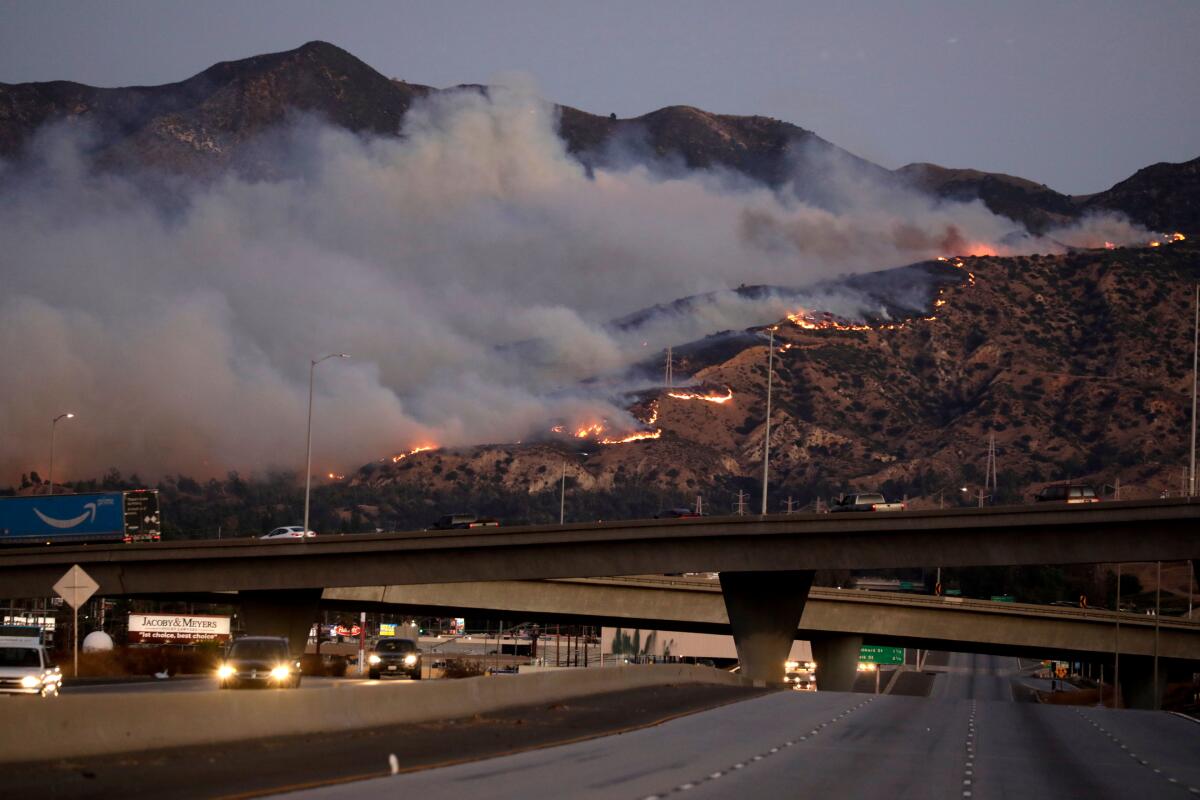Opinion: The Sylmar area has burned three times in recent years. What are we thinking?

The Saddleridge fire in Sylmar at the northern edge of Los Angeles is the latest in a long line of infernos that have chased tens of thousands of Angelenos from their homes, disrupted the region’s massive transportation grid and turned toxic the air that we all breathe.
When is enough, enough? When we will absorb the lessons that nature has been dishing out in Southern California for the past century — that we inhabit a fire-prone terrain, that such conflagrations are a direct result of how we have constructed the sprawling built landscape we inhabit, and that due to climate change there will be plenty more Saddleridge fires in the coming years?
The Saddleridge fire is a microcosm of the larger issues at stake whenever flames sweep across what is called the wildland-urban interface — that space where the natural meets the human-made. Sylmar is perfectly situated to help explain just how complicated and dangerous the interaction can be between fire and the place people call home.
Keep in mind that it is the third such major conflagration to erupt in the Sylmar area alone over the past 11 years.
In November 2008, driven by 80 mile-an-hour Santa Ana winds, the Sayre fire in Sylmar raced through more than 11,000 acres and shut down the five major freeways that crisscross the area — the 5, 210, 14, 405 and the 118. The blaze torched upward of 500 homes and other structures, many of which were manufactured housing. Years later, their skeletal remains were still visible from the 210 Freeway, a ghastly, ghostly reminder of this particular fire’s incendiary rush that forced more than 100,000 people to evacuate.
Nearly the same tragic story played out in December 2017, when the wind-whipped 15,000-acre Creek fire exploded a few miles from where the Sylmar fire had started. During its month-long run, the Creek fire leaped across the same set of freeways as its embers rode the swift Santa Ana winds and set spot fires far in advance of the main blaze. Although the number of structures it consumed were far fewer than in the 2008 fire — “only” 100 went up in smoke— the Creek fire, too, led to a massive evacuation. More than 115,000 were forced to seek shelter.
The flight of residents from the Sylmar area was further complicated by the fact that the Creek fire was just one of a devastating complex of fires that blew up that December. To its west, the monster Thomas fire killed two and burned a then-record 280,000 acres in Ventura and Santa Barbara counties, shutting down the 101 and 118 freeways. Two additional blazes flared up: The Rye fire to Sylmar’s north, consumed a modest 6,000 acres but shut down the hyper-busy Interstate 5. The 422-acre Skirball fire turned the 405 freeway into a gridlocked nightmare.
Then, as now, residents were warned not to get on the highways unless absolutely necessary.
That pragmatic warning is a response to the tight link between housing developments hammered into the wildland-urban interface — the fire zones — and the highway and energy infrastructures that enable people to commute to and from these peripheral communities. And from which they will need to flee every time a fast-moving fire, like the Saddleridge, roars down a canyon, flashes across a highway or takes out the house next door.
Surely it’s time to change this longstanding pattern of flight and (fire)fight. Of building where we should not build. Here, then, is a modest proposal. As soon as firefighters gain control of the Saddleridge fire, local governments should launch open-session discussions about their hitherto seemingly unshakable commitment to green-light housing developments in fire zones. They cannot ignore the reality that their actions have added more fuel to an already flammable landscape and have turned what we have been describing as “wildfires” into structural fires.
To change this dynamic, city and county governments could float bonds to purchase from willing sellers undeveloped or burned acres within the wildland-urban interface, much as flood-prone San Antonio, Texas, has been doing within floodplains to keep people out of harm’s way.
Put another way, local agencies cannot afford to continue to pursue business as usual, use the state’s housing crisis to sanction the construction of vast subdivisions — and hope for the best
As any Sylmar resident can attest, hope is not a fireproof strategy.
Char Miller is a professor of environmental analysis at Pomona College and author of “Not So Golden State: Sustainability vs. the California Dream.”
More to Read
A cure for the common opinion
Get thought-provoking perspectives with our weekly newsletter.
You may occasionally receive promotional content from the Los Angeles Times.










